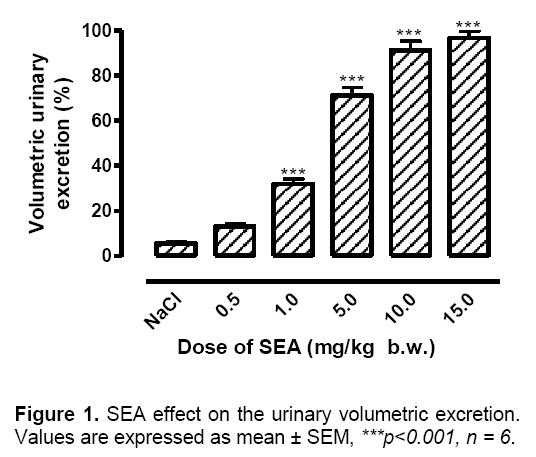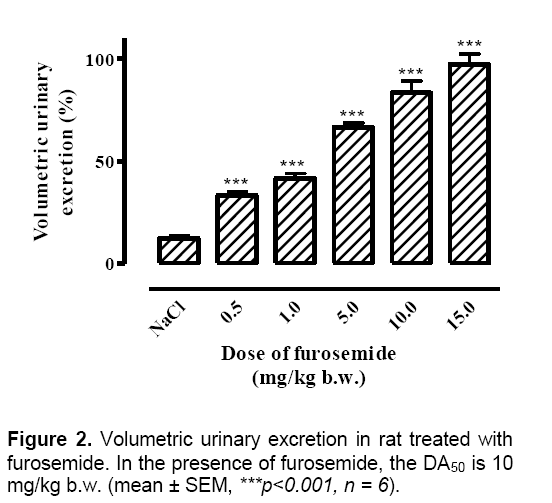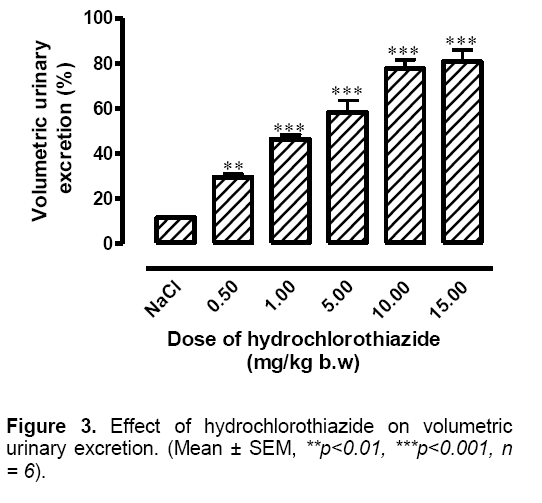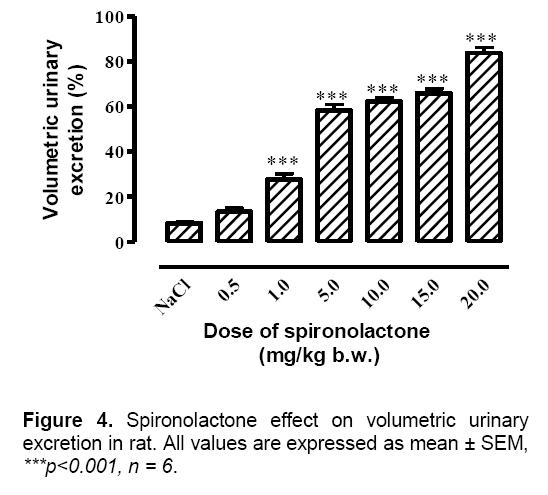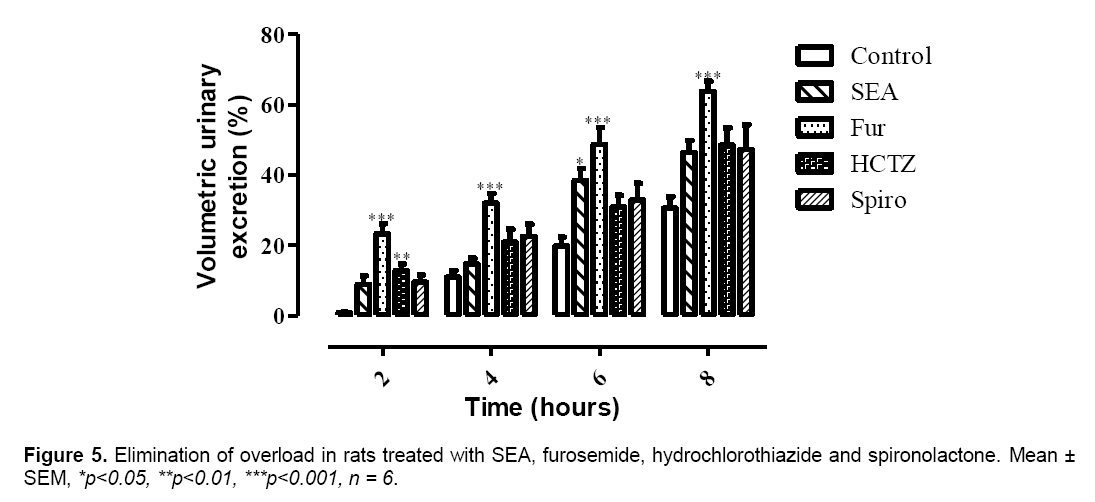Effects of Aqueous Extract of Bridelia ferruginea Benth on the Kinetic of Water Overload Elimination in Normal Rat
Semi Anthelme NENE-Bi, Tianga Yaya SORO, Ouga Stanislas ZAHOUI, Gomé Michel BLEU, NDouffou Célestin EHOUSSOU, Flavien TRAORE
Laboratory of Animal Physiology,UFR Biosciences,University of Cocody-Abidjan,22 BP 582 Abidjan 22,Ivory Coast
Abstract
The effects of an aqueous extract of Bridelia ferruginea stem-bark (SEA) have been evaluated on on the elimination of the water overlaod in male rat. The experiments were carried out under the same conditions with synthetic pharmacological diuretics (furosemide, hydrochlorothiazide, and spironolactone). The parameter which was taken account during the experimentation was total urine volume. The aqueous extract of Bridelia ferruginea, 24 hours after its administration intraperitoneally in the rat, involves a significant (p?0.01) urine output compared to control. This study demonstrated a dose-dependent increase in diuresis in animal treated with Bridelia ferruginea extract. The effect of SEA tends toward those of furosemide. These results seem to justify its use in traditional medicine as diuretic.
Keywords
Bridelia ferruginea,pharmacological diuretic,Urinary excretion,Kinetic.
1. Introduction
In African cultural groups,traditional medicine is frequently used in the treatment of several pathologies. From the perspective of drug development to enhance the traditional Pharmacopoeia,we undertook the pharmacological study of Bridelia ferruginea (Euphorbiaceae) which is a common savannah of genus Bridelia. Though present in the forest vegetation but it is commonly found in the savannah. The bark is dark grey,rough and even markedly scaly [1,2]. This plant is widely used in traditional African medicine in the treatment of arterial hypertension or as diuretic agents and purgative [3-5]. The aqueous extract of the stem-bark of this plant is used in herbal medicine as sedatives [6] and contains quinones,gallic and catechic tannins,alkaloids,sterols,polyterpenes,polyphenols,reducing compounds,flavonoids and saponosides [7]. According to Nene-bi et al. [8],the aqueous extract of Bridelia ferruginea provoked the hypotensive effect in the rabbit. In view of this,the aim of the present study was to investigate the effect of an aqueous extract of Bridelia ferruginea stem-bark on the elimination of the water overlaod.
2. Materials and Methods
2.1 Plant material
The plant material of the present study,Bridelia ferruginea stem bark was obtained at market from Yopougon (Ivory Coast). These stem barks were identified by an expert,Professor Ake-Assi Laurent a botanist of the National Floristic Center of Ivory Coast (University of Cocody-Abidjan). A voucher specimen (herbarium No. 17148 of August 19,1985) was retained in this center.
2.2 Preparation of the extract
The stem barks were dried in the shade at room temperature between 26 ° C and 30 ° C and powdered with a micro-crusher. The powder obtained (50 g) was macerated for 24 hours in a 1 liter of distilled water using magnetic stirrer. The supernatant was filtered with Whatman No 1 filter paper and it was evaporated using rotating evaporator. The solvent was completely removed under reduced pressure to obtain a dry mass. The aqueous extract of Bridelia ferruginea stem-bark (SEA) obtained was stored at -5 ° C. The concentrations to be tested were prepared extemporaneously by dilution in saline solution at the dose of 9 ‰.
2.3 Animals
Male Wistar rats (Rattus norgevicus) weighting 150-200 g were used. Animals of the same treatment group were housed in a temperature (26 ± 4°C) and humidity (60 %) controlled room using a 12/24 hours cycle. They were bred in animal house of UFR Biosciences (Animal Physiology laboratory,University of Cocody-Abidjan) and had access to food and water ad libitum. The tests were performed only after rats had acclimated to the above environment. All procedures were approved by University of Cocody-Abidjan ethical committee and in accordance with the national government accepted principles for laboratory animal.
2.4 Diuretic activity
Thirty male Wistar rats were used in all experiments. These rats were divided into 5 equal groups (n = 6/group). After 18 hours of total diet,the rats received 50 ml/kg of body weight (b.w.) distilled water orally before treatments. The dose-response study was carrying with the aqueous extract of Bridelia ferruginea,furosemide,hydrochlorothiazide and spironolactone. Those substances were administrated intraperitoneally to the rats. According Gallez et al. [9],the intraperitoneal administration in rat presents high absorption rate compared to oral administration. This administration mode provides better bioavailability of the test substance in animals. All reference drugs were purchased from pharmacy. The animals in the control group were received intraperitoneally saline solution at the dose of 9 ‰. The rats were placed in metabolic cages (one in each cage) specially designed to separate the urine and feces and maintained at room temperature. The urine volumes were determined after 24 hours to determine the average diuretic activity (DA50) of all substances and these doses are used to study the speed of the elimination of the water overlaod in male rat after eight (08) hours.
2.5 Statistical Analysis
The statistical analysis was performed using oneway analysis of variance (ANOVA) of the multiple test of comparison of Tukey-Kramer. The level of significance was determined in comparison with the control group. p<0.05 was considered significant. All values are expressed as mean ± SEM.
3. Results and Discussion
The intraperitoneal injection of SEA,at doses ranging from 0.5 to 15 mg/kg b.w. increases diuresis in rat. For doses ranging 1 to 15 mg/kg b.w.,SEA produces relatively large urinary volumes respectively of 16 ± 1.07 and 48.33 ± 1.56 ml/kg/24 hours of b.w. corresponding at the volumetric urinary excretions of 32 ± 2.13 % (p<0.001) and 96.67 ± 3.13 % (p<0.001) (Figure 1).
In rat treated with furosemide at doses ranging from 0.5 to 15 mg/kg b.w.,the urine volumes significantly (p<0.001) increased. The increase in the urinary volumes excreted in rats treated with the furosemide as SEA is dose-dependent. For doses between 0.5 and 15 mg / kg b.w.,urine volume excreted varies from 16.66 ± 0.88 to 48.67 ± 2.5 hours ml/kg/24 hours b.w.. Changes in urinary volume as a function of increasing doses of furosemide allows to determine an DA50 to 10 mg/kg b.w. (Figure 2 ).
After the hydrochlorothiazide administration at the doses ranging from 0.5 to 15 mg / kg b.w. in rat,the urine volumes were respectively from 14.75 ± 0.70 (p<0.05) to 40.33 ± 2.64 ml/kg/24 hours of b.w. (p<0.01). At those doses,the volumetric urinary excretions were significantly increased from 29.5 ± 1.41 % to 80.67 ± 5.28 % (Figure 3 ). In animal treated with hydrochlorothiazide,the DA50 was of 15 mg/kg b.w.
With the spironolactone,the doses ranging from 0.5 to 20 mg / kg b.w. were used in rat. Those doses provoke a significantly increase of the urine volumes and induced respectively the volumetric urinary excretion from 27.83 ± 2.43 % to 83.80 ± 2.5 % (Figure 4 ). The DA50 obtained with that substance was 20 mg / kg b.w.
After the determination of different DA50,the doses corresponding to these values are administered to rats. The effects of these doses were observed for eight hours and urinary volumes were measured every 2 hours (Figure 5 ). The aqueous extract of Bridelia ferruginea accelerates the elimination of water overload significantly (p < 0.05) and produces urinary volume of 19.22 ± 1.72 ml/kg in rat at 6 hours after its administration compared to control (9.89 ± 1.28 ml/kg). This elimination induces by SEA is lower than that of furosemide (24.33 ± 2.43 ml/kg vs 9.89 ± 1.28 ml/kg).
The study shows that the aqueous extract of Bridelia ferruginea (SEA) has significant and dosedependent diuretic activity in rats. This result was similar to those observed with Urtica dioica [10],Lavandula officinalis [11],Cocculus hirsutus [12],Spilanthes acmella [13],Steganotaenia araliacea [14],Retama raetam [15],and Karavi Panchaka [16],which induce an increase of the urine output. With SEA,the volume of urine excreted was significant,but that effect was lower than that of furosemide. The kinetic of water overload elimination in rat shows that SEA provokes significant diuresis. The finding is comparable for these observed with Lavandula officinalis [11].
The increase in urinary excretion induced by SEA could be due either to a direct effect on the active components of the transport,or an indirect effect by a modification of the oncotic and hydrostatic pressures in peritubular capillaries [17,18].
4 Conclusions
The effects of the aqueous extract of Bridelia ferruginea on diuresis was higher than those obtained with the hydrochlorothiazide and the spironolactone,but lower than that of furosemide.
These results suggest that the aqueous extract of Bridelia ferruginea induces a diuretic response. These findings support the traditional use of this plant.
Acknowledgements
Authors thanks to Ministry of Science and Technology (MoST),Islamabad Pakistan for financial support under the project “Production of Bioenergy from Plant Biomass.”
References
- Rashid M.A.,Gustafson K.R.,Cardellina J.H. II,et al. (2000) A New Podophyllotoxin Derivative from Bridelia ferruginea. Nat Pro Let,14: 285-292.
- Jose R.A.,Kayode J. (2009) The Effect of Bridelia ferruginea Bark Extracts on Some Pathogenic Micro-Organisms. Ethnobotanical Leaflets,13: 1042-1046.
- Bouquet A.,Debray M. (1974) Plantes médicinales de la Côte d’ivoire. Travaux de l’O R S T O M,32: 83-87.
- Diafouka A.J.P. (1997). Analyse des usages des plantes médicinales dans quatre Régions du Congo - Brazzaville. Thèse de Doctorat en Sciences,Université libre de Bruxelles,Faculté des Sciences. Laboratoire de Botanique Systématique et de Phytosociologie. Belgique. pp.362.
- Cimanga K.,De Bruyne T.,Apers S.,et al. (1999) Compliment-inhibiting constituents of Bridelia ferruginea stem bark. Planta Med,65: 231-317.
- Nene-Bi S.A.,Zahoui O.S.,Soro T.Y.,et al. (2010) Évaluation de l’effet d’un extrait aqueux de Bridelia ferruginea Benth. (Euphorbiaceae) sur les activités spontanée et locomotrice chez le rat. IJBCS,04(1): 34-41.
- Nene-Bi S.A.,Traore F.,Soro T.Y.,et al. (2009) Etudes phytochimique et pharmacologique de Bridelia ferruginea Benth (Euphorbiaceae) sur la motricité du Taenia coli de cobaye. Afrique Science,05(2): 305-320
- Nene-Bi S.A.,Traore F.,Zahoui O.S.,et al. (2008) Composition chimique d’un extrait aqueux de Bridelia ferruginea Benth (Euphorbiaceae) et études de ses effets toxicologique et pharmacologique chez les mammifères. Afrique Science,04(2): 287-305.
- Gallez B.,Demeure R.,Baudelet C.,et al. (1999) Evaluation par RMN de l’intoxication cérébrale par le manganèse. Louvain Med,118: 165-168.
- Tahri A.,Sabah Y.,Legssyer A.,et al. (2000) Acute diuretic,natriuretic and hypotensive effects of a continuous perfusion of aqueous extract of Urtica dioica in the Rat. J Ethnopharmacol,73: 95-100.
- Elhajili M.,Baddouri K.,Elkabbaj S.,et al. (2001) Effet diurétique de l’infusion de fleurs de Lavandula officinalis. Reprod Nutr Dev,41: 393-399.
- Ganapaty S.,Dash G.K.,Subburaju T.,et al. (2002) Diuretic,laxative and toxicity studies of Cocculus hirsutus aerial parts. Fitoterapia,73(1): 28-31.
- Ratnasooriya W.D.,Pieris K.P.,Samaratunga U.,et al. (2004) Diuretic activity of Spilanthes acmella flowers in rats. J Ethnopharmacol,91(2-3): 317-320.
- Agunu A.,Abdurahman E.M.,Andrew G.O.,et al. (2005) Diuretic activity of the stem-bark extracts of Steganotaenia araliacea hochst (Apiaceae). J Ethnopharmacol,96(3): 471-475.
- Maghrani M.,Zeggwagh N.A,Haloui M.,et al. (2005) Acute diuretic effect of aqueous extract of Retama raetam in normal rats. J Ethnopharmacol,99(1): 31-35.
- Welihinda J.,Ariyawansa H.A.,Wickramasinghe R. (2006) Comparison of the diuretic effects of furosemide and the Karavi Panchaka Ayurveda decoction. Ceylon Med J,51(3): 93-97.
- Lewy J.E.,Windhager E.E. (1968) Peritubular control of proximal fluid reabsorption in the rat kidney. Amer J Physiolo,214: 943.
- Brenner B.M.,Falchuk K.H.,Keimowitz R.L.,et al. (1969) The relationship between peritubular capillary protein concentration and fluid reabsorption by the renal proximal tubule. J Clin Invest,48: 1519.

Open Access Journals
- Aquaculture & Veterinary Science
- Chemistry & Chemical Sciences
- Clinical Sciences
- Engineering
- General Science
- Genetics & Molecular Biology
- Health Care & Nursing
- Immunology & Microbiology
- Materials Science
- Mathematics & Physics
- Medical Sciences
- Neurology & Psychiatry
- Oncology & Cancer Science
- Pharmaceutical Sciences
